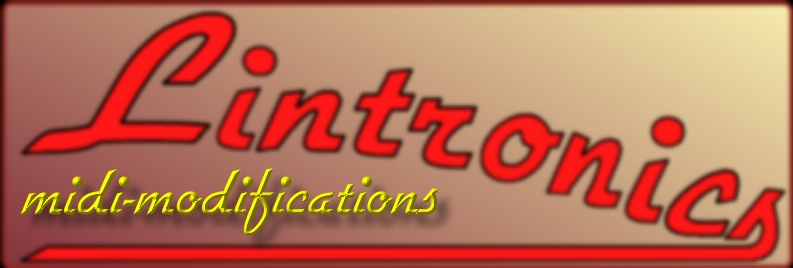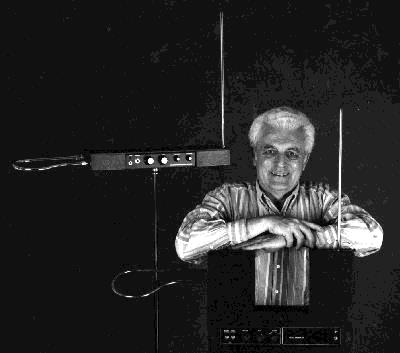AND OTHER MONOPHONIC ANALOG SYNTHS

During the 1970's, several manufacturers introduced monophonic analog synthesizers to performing musicians. Based on the sound-producing capabilities of the earlier modular analog synthesizers, these instruments used voltage-controlled oscillators, filters, and amplifiers to enable musicians to impart a wide range of novel, expressive gestures to their music. The sounds produced by these instruments have become an important feature of our contemporary popular music. Today the sounds of these 'vintage' instruments are collectively called the 'classic analog sound', and the vintage instruments themselves are enjoying increasing popularity. Among these, the Minimoog a arguably has become the standard of comparison.
The Lintronics MIDI Converter ("LMC") is a feature-rich, high-performance MIDI interface that is designed specifically to place the expressive potential of the Minimoog and certain other monophonic analog synthesizers under MIDI control. Designed by Rudi Linhard (who also designed the Lintronics Advanced Memorymoog Modification), the LMC uses state-of-the-art digital circuitry and software. It includes an internal Low Frequency Oscillator (LFO), which can be used in addition to, or in place of the host synth's LFO. Pitch, pitch bend, filter cutoff, loudness, modulation amount, and the internal LFO's (Low Frequency Oscillator) rate and depth, all may be controlled through MIDI in real time and with high resolution. In addition, the Glide and Decay functions may be turned on and off through MIDI. A wide range of controller assignments, keyboard modes, and similar options are accessed through MIDI Program Change commands. And the LMC includes a programmable wide range multiwaveform LFO which can be used in addition to or in place of the host synth's LFO. Finally, the LMC circuitry is contained on a single small circuit board which is designed to be installed inside the host synth, and to use the host computer's power supply.
HOW IT WORKS
The microprocessor section receives MIDI data from the MIDI IN connector, processes it, and
sends a continuous stream of numbers representing the values of five voltages to the Digital-to-Analog (D/A) section. The Multiplexer section 'fans out' the D/A voltage output to five control
signals: Key, Pitch Bend, Filter, LFO and Volume.
A sixth control signal varies the resistance of a photoresistor that controls Modulation
Amount. The microprocessor also produces three switching signals which are used to turn the notes on and off (Gate) and to switch the Glide and Decay functions. The ranges of the LMC's various
outputs are given in the Technical Specifications section at the end of this bulletin.
The LMC circuitry is powered from the on-board Dual Power Regulator section. A total
current of 50 milliamperes is drawn from the host computer's synth's power supply.
THE FEATURE SET (LMC-1 VERSION)
All of the LMC's software is resident in permanent ROM within the microprocessor.
Upon power-up, the LMC comes on with a factory-installed group of default settings. After power-up, the musician may use MIDI Program Change messages at any time to change the LMC's
operating features. Or, he may also filter out Program Change messages at any time to prevent MIDI Program Change data from changing the LMC's settings.
MIDI Program Change numbers 1-65 are used to select the LMC's settings. Here is a
complete list describing the LMC settings that are accessed through via Program Change messages. Each entry on this list tells which setting is the power-on default, and what Program Change
numbers are used.
MIDI CHANNEL: PROGRAM CHANGE NUMBERS 1-16: Selects which basic MIDI channel for the
LMC will respond to. DEFAULT: Channel 1. PROGRAM CHANGE NUMBERS: 1-16.
PROGRAM CHANGE ENABLE/DISABLE: PROGRAM CHANGE NUMBERS 17-18: Determines whether or not the
LMC will respond to further Program Change messages. Program Change 17 enables the LMC to respond to subsequent Program Change messages, while Program Change 18 filters out all
subsequent Program Change messages except number 17.
VOLUME CONTROL: PROGRAM CHANGE NUMBERS 19-24: Selects one of the following MIDI control
sources: Note-on Velocity; Aftertouch; Channel Volume (Control 7); or None (maximum volume) . If MIDI Control #7 is not selected, then volume control via MIDI Control #2/#4 (Breath Controller and/or
Foot Pedal) may also be enabled. DEFAULT: None (Maximum volume). PROGRAM CHANGE NUMBERS: 19-24.
FILTER CUTOFF: PROGRAM CHANGE NUMBERS 25-29: Selects one of the following MIDI control
sources: Note-on Velocity; Aftertouch, MIDI Control #2/#4 (Breath Controller and/or Foot Pedal); MIDI Control #1 (Mod Wheel); or None. DEFAULT: None (No filter control via MIDI). PROGRAM CHANGE NUMBERS: 25-29.
CONTROL OF MOD AMOUNT BY AFTERTOUCH: PROGRAM CHANGE NUMBERS 30-31: Enables or disables.
DEFAULT: Off. PROGRAM CHANGE NUMBERS: 30 & 31.
PITCH BEND RANGE: PROGRAM CHANGE NUMBERS 32-33: Either +/- 3 semitones or +/ 6 semitones.
DEFAULT: 3 semitones. PROGRAM CHANGE NUMBERS: 32 & 33.
KEY PRIORITY: PROGRAM CHANGE NUMBERS 34-35: Either the highest of all notes on will play, or
the lowest of all notes on will play. DEFAULT: Lowest. PROGRAM CHANGE NUMBERS: 34 & 35.
KEYBOARD NORMAL/INVERSE: PROGRAM CHANGE NUMBERS 36-37: In the inverse mode, the note's pitch
goes down as the MIDI note number goes up. DEFAULT: Normal. PROGRAM CHANGE NUMBERS: 36 & 37.
MOD. WHEEL PRODUCES KEYBOARD GLISSANDO: PROGRAM CHANGE NUMBERS 38-39: Enables or disables.
DEFAULT: Off.
MOD. WHEEL SETS LFO SPEED: PROGRAM CHANGE NUMBER 40: Hold a key, send Program Change #40,
set the LFO speed with your Mod. Wheel, then release the key.
WAVEFORM OF ON-BOARD LFO: PROGRAM CHANGE NUMBERS 41-47: Selects one of the following:
Sine Wave; Triangle; Falling Sawtooth; Rising Sawtooth; Square; Rectangular - 25% Width; Rectangular - 12.5% Width; and Random Sample & Hold. DEFAULT: triangle. PROGRAM CHANGE NUMBERS: 41-47.
WAVEFORM POLARITY: PROGRAM CHANGE NUMBERS 48-49: Choice of either positive-going or
negative-going. DEFAULT: Positive-going. PROGRAM CHANGE NUMBERS 48 & 49.
WAVEFORM SPEED RANGE: PROGRAM CHANGE NUMBERS 50-52: Choice of fast, medium, or slow.
DEFAULT: Fast. PROGRAM CHANGE NUMBERS 50-52.
WAVEFORM RESET: PROGRAM CHANGE NUMBERS 53-54: Choice of whether or not the on-board LFO
waveform resets whenever a new note starts. DEFAULT: Off. PROGRAM CHANGE NUMBERS: 53 & 54.
KEYBOARD MODE: PROGRAM CHANGE NUMBERS: 55-64: Determines whether the LMC responds to
all MIDI note-on messages (Mono mode), or whether it responds to every eighth note-on (Eight-note Polyphony). DEFAULT: Mono. PROGRAM CHANGE NUMBERS: 55-64.
SYSTEM RESET: PROGRAM CHANGE NUMBER 65: Resets all settings to their power-on defaults.
PROGRAM CHANGE NUMBER: 65.
TECHNICAL SPECIFICATIONS (LMC-2 VERSION)
Power Supply......... +/- 10-15 Volts, 50 mAKey Range............ 64 semitones C1 to D#6
Pitch Bend Range..... max +/- 6 semitones, 14 bit resolution
CV 1................. 0 to +5 Volts
CV 2................. 0 to +5 Volts
VCA 1................ max +/- 10 Volts
VCA 2................ max +/- 10 Volts
MIDI Clock........... hi/lo active
MIDI Start/Stop...... hi/lo active
LFO voltage output... +/- 5 Volts
LFO Waveforms........ Sine Wave, Triangle, Rising Sawtooth, Falling Sawtooth,
Square Wave (50%), Rect. Wave 25%, Rect. Wave 12.5%, Random
Take a look to the Moogmusic Homepage!
Phone: +49-9102-999515
E-mail: info@lintronics.de
Address: LINTRONICS, Franziska-Barbara-Str. 10
91452 Wilhermsdorf, GERMANY

